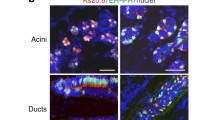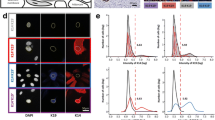Abstract
DNA repair, a fundamental function of cellular metabolism, has long been presumed to be constitutive and equivalent in all cells. However, we have previously shown that normal levels of nucleotide excision repair (NER) can vary by 20-fold in a tissue-specific pattern. We have now successfully established primary cultures of normal ovarian tissue from seven women by using a novel culture system originally developed for breast epithelial cells. Epithelial cells in these cultures aggregated to form three-dimensional structures called “attached ovarian epispheres”. The availability of these actively proliferating cell cultures allowed us to measure NER functionally and quantitatively by the unscheduled DNA synthesis (UDS) assay, a clinical test used to diagnose constitutive deficiencies in NER capacity. We determined that ovarian epithelial cells manifested an intermediate level of NER capacity in humans, viz., only 25% of that of foreskin fibroblasts, but still 2.5-fold higher than that of peripheral blood lymphocytes. This level of DNA repair capacity was indistinguishable from that of normal breast epithelial cells, suggesting that it might be characteristic of the epithelial cell type. Similar levels of NER activity were observed in cultures established from a disease-free known carrier of a BRCA1 truncation mutation, consistent with previous normal results shown in breast epithelium and blood lymphocytes. These results establish that at least three “normal” levels of such DNA repair occur in human tissues, and that NER capacity is epigenetically regulated during cell differentiation and development.




Similar content being viewed by others
References
Auersperg N, Maines-Bandiera SL, Dyck HG (1997) Ovarian carcinogenesis and the biology of ovarian surface epithelium. J Cell Physiol 173:261–265
Cleaver JE (2005) Cancer in xeroderma pigmentosum and related disorders of DNA repair. Nat Rev Cancer 5:564–573
Engel LW, Young NA (1978) Human breast carcinoma cells in continuous culture: a review. Cancer Res 38:4327–4339
Ferry KV, Hamilton TC, Johnson SW (2000) Increased nucleotide excision repair in cisplatin-resistant ovarian cancer cells: role of ERCC1-XPF. Biochem Pharmacol 60:1305–1313
Forlenza M, Latimer J, Baum A (2000) The effects of stress on DNA repair capacity. Psychol Health 15:881–891
Hanawalt PC, Ford JM, Lloyd DR (2003) Functional characterization of global genomic DNA repair and its implications for cancer. Mutat Res 544:107–114
Hartman A-R, Ford JM (2002) BRCA1 induces DNA damage recognition factors and enhances nucleotide excision repair. Nat Genet 32:180–184
Kelly CM, Latimer JJ (2005) Unscheduled DNA synthesis: a functional assay for global genomic nucleotide excision repair. Methods Mol Biol 291:303–320
Kennedy DO, Agrawal SJ, Terry MB, Zhang FF, Senie RT, Motykiewicz G, Santella RM (2005) DNA repair capacity of lymphoblastoid cell lines from sisters discordant for breast cancer. J Natl Cancer Inst 97:127–132
Kleijer WJ, Sterre MLT van der, Garritsen VH, Raams A, Jaspers NGJ (2007) Prenatal diagnosis of xeroderma pigmentosum in 76 pregnancies at risk. Prenat Diagn 27:1133–1137
Kovacs E, Almendral A (1987) Reduced DNA repair synthesis in healthy women having first degree relatives with breast cancer. Eur J Cancer Clin Oncol 23:1051–1057
Kovacs E, Stucki D, Weber W, Müller HJ (1986) Impaired DNA-repair synthesis in lymphocytes of breast cancer patients. Eur J Cancer Clin Oncol 22:863–869
Kraemer KH, Lee MM, Scotto J (1984) DNA repair protects against cutaneous and internal neoplasia: evidence from xeroderma pigmentosum. Carcinogenesis 5:511–514
Latimer JJ (2000) Epithelial cell cultures useful for in vitro testing. US patent no. 6,074,874
Latimer JJ, Hultner ML, Cleaver JE, Pedersen RA (1996) Elevated DNA excision repair capacity in the extraembryonic mesoderm of the midgestation mouse embryo. Exp Cell Res 228:19–28
Latimer JJ, Nazir T, Flowers LC, Forlenza MJ, Beaudry-Rodgers K, Kelly CM, Conte JA, Shestak K, Kanbour-Shakir A, Grant SG (2003) Unique tissue-specific level of DNA nucleotide excision repair in primary human mammary epithelial cultures. Exp Cell Res 291:111–121
Latimer JJ, Rubinstein WS, Johnson JM, Kanbour-Shakir A, Vogel VG, Grant SG (2005) Haploinsufficiency for BRCA1 is associated with normal levels of DNA nucleotide excision repair in breast tissue and blood lymphocytes. BMC Med Genet 6:26
Li Q, Yu JJ, Mu C, Yunmbam MK, Slavsky D, Cross CL, Bostick-Bruton F, Reed E (2000) Association between the level of ERCC-1 expression and the repair of cisplatin-induced DNA damage in human ovarian cancer cells. Anticancer Res 20:645–652
Martin GM, Ogburn CE, Colgin LM, Gown AM, Edland SD, Monnat RJ Jr (1996) Somatic mutations are frequent and increase with age in human kidney epithelial cells. Hum Mol Genet 5:215–221
Milo Y, Deutsch AA, Zahavi S, Ingber A, Reiss R (1994) Xeroderma pigmentosum with recurrent infiltrating ductal carcinoma of breast. Postgrad Med J 70:240–241
Narod SA (1994) Genetics of breast and ovarian cancer. Br Med Bull 50:656–676
Reed E (1998) Platinum-DNA adduct, nucleotide excision repair and platinum based anti-cancer chemotherapy. Cancer Treat Rev 24:331–344
Rosen EM, Fan S, Pestall RG, Goldberg ID (2003) BRCA1 gene in breast cancer. J Cell Physiol 196:19–41
States JC, Reed E (1996) Enhanced XPA mRNA levels in cisplatin-resistant human ovarian cancer are not associated with XPA mutations or gene amplification. Cancer Lett 108:233–237
Tada T, Tada M (2001) Toti-/pluripotential stem cells and epigenetic modifications. Cell Struct Funct 26:149–160
Takimoto R, MacLachlan TK, Dicker DT, Niitsu Y, Mori T, el-Deiry WS (2002) BRCA1 transcriptionally regulates damaged DNA binding protein (DDB2) in the DNA repair response following UV-irradiation. Cancer Biol Ther 1:177–186
Ting AH, McGarvey KM, Baylin SB (2006) The cancer epigenome—components and functional correlates. Genes Dev 20:3215–3231
Van Hoffen A, Balajee AS, Zeeland AA van, Mullenders LH (2003) Nucleotide excision repair and its interplay with transcription. Toxicology 193:79–90
Xiong P, Bondy ML, Li D, Shen H, Wang LE, Singletary SE, Spitz MR, Wei Q (2001) Sensitivity to benzo(a)pyrene diol-epoxide associated with risk of breast cancer in young women and modulation by glutathione S-transferase polymorphisms: a case-control study. Cancer Res 61:8465–8469
Yu JJ, Bicher A, Ma YK, Bostick-Bruton F, Reed E (2000) Absence of evidence for allelic loss or allelic gain for ERCC1 or for XPD in human ovarian cancer cells and tissues. Cancer Lett 151:127–132
Acknowledgements
We gratefully acknowledge the technical support of Amar V. Patel, Julie A. Conte, Elena Kisin, Lori W. Thomas, Amie L. Benson, Lynne R. Janczukiewicz, Amanda K. Blockinger, Crystal M. Kelly, and Nicole T. Myers in completing this study.
Author information
Authors and Affiliations
Corresponding author
Additional information
This work was supported by grants from the US National Institutes of Health (R29 CA7189), the Army Breast Cancer Research Program (DAMD17-00-1-0409, DAMD17-00-1-0651, DAMD17-00-1-0681, W81X-04-1-0685, W81XWH-04-1-0686), the Susan G. Komen Foundation (BCTR0403329, DISS00403112, POP99806), the Glimmer of Hope Foundation, the Ruth Estrin Goldberg Foundation, and the Pennsylvania Department of Health.
Rights and permissions
About this article
Cite this article
Latimer, J.J., Johnson, J.M., Miles, T.D. et al. Cell-type-specific level of DNA nucleotide excision repair in primary human mammary and ovarian epithelial cell cultures. Cell Tissue Res 333, 461–467 (2008). https://doi.org/10.1007/s00441-008-0645-1
Received:
Accepted:
Published:
Issue Date:
DOI: https://doi.org/10.1007/s00441-008-0645-1




